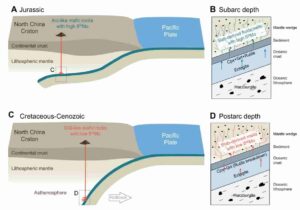
Recently, a research team led by Prof. Dai Liqun from the University of Science and Technology of China (USTC) of the Chinese Academy of Science (CAS), has revealed that the mantle sources of Cenozoic and Mesozoic mafic igneous rocks from the eastern North China craton had gone through different types of metasomatism at different depths by comparing the composition of molybdenum isotopes. Their work was published in Geology.
Subducting slabs precipitate fluids with different compositions and properties at different depths, and when interacting with mantle wedge rocks, metasomatism occurs near the interface due to significant difference in physical condition and composition. Such metasomatism changes the chemical composition of mantle wedge rocks and produces different types of magmatism. By determining the composition of magmatic rock, researchers can study the interaction of mantles at different depths, therefore revealing the structure of the subduction zone.
DAI’s team compared the composition of molybdenum isotopes in the Mesozoic-Cenozoic mafic igneous rock in the eastern North China craton and discovered a systematic difference, indicating a difference in molybdenum isotopes composition in the fluids derived in the subducting oceanic slabs at subarc and postarc depths.
The team also discovered that Mesozoic mafic igneous rocks have island-arc basalt-like features and a heavier molybdenum isotopes composition than regular mantles, indicating that they came from subducting oceanic slab-derived fluids at subarc depths in a small mantle wedge. In contrast, Cenozoic mafic igneous rocks show oncean-island basalt-like features and have lighter molybdenum isotopes than regular mantles, coming from dehydrated slab-derived melts at postarc depths in a large mantle wedge.
The difference in molybdenum isotopes composition with rutile stability at different depths was explained. Molybdenum in subducting slabs was mainly hosted in mineral rutile, which was stable at subarc depths but broke down at postarc depth. Moreover, by combining the research on Sr-Nd isotopes with that on Mo isotopes, the team further verified that the mantle source of Mesozoic and Cenozoic mafic igneous rock had gone through different types of metasomatism at different depths.
This work provided an effective method to study the interaction of mantles at different depths, which can help the understanding of subduction zone structure in the future.
Reference:
Wei Fang et al, Molybdenum isotopes in mafic igneous rocks record slab-mantle interactions from subarc to postarc depths, Geology (2022). DOI: 10.1130/G50456.1
Note: The above post is reprinted from materials provided by University of Science and Technology of China.










